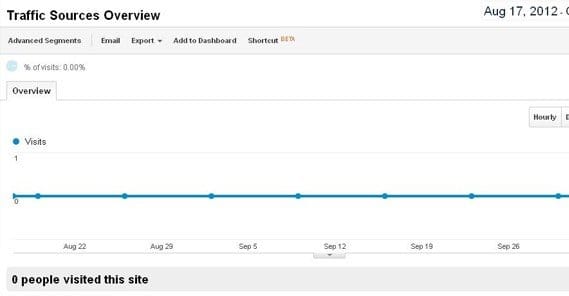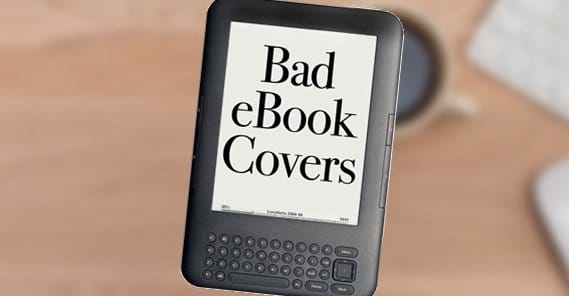5 Reasons Your eBook Isn’t Getting Enough Sales

For the most part, eBooks exist to be sold. Sometimes you’re “selling” them in exchange for email addresses, occasionally you’ll give them away, but most of the time you’re trying to exchange your knowledge for money. You want a good return on your investment. It doesn’t matter if that investment was in a ghostwriter and graphic designer to create it, or in your own time and energy making it; there’s value there, and you want returns.
So why is it, then, that your eBook is sitting on the virtual shelves collecting virtual dust? Why does it languish in the bottom million publications on Amazon? Why is there no interest in it on your site?
Let’s cover some of the most frequent reasons:
1. Your Book Isn’t Very Good
This is the first potential issue you might have to face. Sometimes, despite your best efforts, the product you create just isn’t very good. It might have something minor wrong with it, or it might have a lot of issues; I don’t know. I recommend soliciting the feedback of someone who is willing to disillusion you and give you a breakdown of what you actually need to fix to make a good book. That means someone other than your mom, wife, or favorite teacher.
Here are some common issues I’ve seen with eBooks. These are issues that crop up with manuscripts as well, though you see them less often in the wild because manuscripts require passage through an editor before publication, whereas anyone can put anything up on Amazon.
- It’s too long. Only fiction authors are typically able to get away with lengthy novels. If you’re writing a nonfiction book on a business, marketing, or industry subject, you can’t write it to be excessively long. You’re probably going to shoot for something in the 50-75 thousand word range. If you’re coming close to 100,000, you’re reaching a danger zone. That’s not to say that lengthy books don’t sell, but they need a different kind of marketing to sell well.
- It’s not specific enough to be useful. Don’t just say something like “contact an industry expert for a testimonial.” Tell me how to find an industry expert, what to say when I reach out to them, and how to ask for a testimonial without seeming pushy. Walk me through the process. I’m paying for the book, I don’t want something I can find on a blog for free.
- It’s rehashed information with nothing new. If I buy your book and all I see are blog posts copied and pasted with some minor introductory material, I’m not going to be happy. If I buy your book and all I see is advice cribbed from other more authoritative blogs, I’m going to be even less happy, and I might be notifying the people whose information you’re taking. Make sure you’re bringing something new to the table if you want to succeed.
- It has no graphic design to it. I’ve seen a lot of novice bloggers make eBooks that are little more than a txt or .docx file converted into a PDF or epub book, with nothing to differentiate it. I’ve also seen blog post formatting in eBooks. You have a lot more flexibility with your presentation! Include images, include graphic design, include typography, make it pop. Just make sure your graphic design doesn’t get lost on a Kindle, with its black and white screen.
- It’s poorly formatted. I’ve seen this a few times; people make a decent eBook, but when they run it through the system to convert it into a format ready for publication, something breaks. Line breaks disappear or double, spaces go missing, title formatting changes, the works. The problem is, if you don’t check and proof-read it, it puts a very poor impression forward. Who wants to buy your book when they look inside and see a mess?
- It’s poorly written. Sometimes there’s no two ways around it; the book you wrote isn’t written well. It has grammatical errors, it has spelling errors, it mixes affect and effect, they’re and their, and all the rest of the homophones. It might be time to step back and realize writing isn’t for you, and you should hire a ghostwriter to do the work instead. There’s no shame in it; plenty of the content on blogs and on Amazon is written by people other than the author.
If you’ve made it past all of these errors and haven’t found them in your book – or haven’t had them pointed out to you – you can move on to number two.
2. You’re Not Properly Marketing
Your book is a product like any other, and it needs to be marketed as such. You can’t create it, throw it up on Amazon or on your blog in a sidebar, and let the sales roll in. You’re going to need to do a lot of work to market that book, get attention to it, and get people interested in it. A lot of that work should be done before the book even comes out, too.
You need to establish a sales funnel, which may or may not lead to paid advertising. A sales funnel begins with some form of advertising, whether it’s social media, blogger outreach, or good old-fashioned paid ads. They all lead to various landing pages, where you put the squeeze on and get users to decide they really want to know what’s inside your eBook. From there, you drag them to the purchase page, and make the sale. That’s a vast simplification, of course, but I’m not writing an eBook about eBook marketing right now. Maybe another time.
A huge part of successfully marketing an eBook comes with the pre-release hype. The moment you have an idea for an eBook, come up with a title and an elevator pitch. Refine those as much as possible and start mentioning them, hinting at them, and circulating them. Once they start to gain a little popularity, reveal the cover design, which you should have professionally created. You can even go a step further and hold contests to select one of several options, which gives you a change to gauge public reaction to your topic and your ideas.
From there, it’s all about spreading the hype. Mention it everywhere. Guest post about it. Mention it in interviews. Post about it on social media. You can even start taking pre-orders, as another interest check.
At some point, you can begin to send out preview copies to influential people who might have an interest in it. They get an exclusive bit of content to review, and you get valuable reviews and backlinks.
You also need to format your book for widespread usage. Selling through Amazon Kindle and Smashwords, as well as on your own website, means you should have your book available in formats readable in a number of ways and locations. You want your eBook to be visible on kindles, on tablets, and on computers of all types.
3. You Have No Supplemental Content
There’s something of a cycle of interconnected content throughout the web and your business that you can use to sell more books. Think of it like a support network that helps people find what they need, while also convincing them that what they need is your book. For example:
- Free content on your site can lead to book sales. People like your business, they like your brand, they like your blog, and they assume that the quality you showcase in those locations will carry over to your eBook. You sell eBooks based on the strength of your non-eBook content.
- Book sales can lead to seminars, webinars, speeches and consults. If you mention that you do consulting or that you have regular webinars with open enrollment for a fee, you’ll have people interested in attending them based on the quality of the content in your books.
- Webinars and the like can lead to more book sales. When you give a webinar, you can mention that you cover certain topics in more detail in your book. Some of your audience will have read the book and will be able to vouch for its utility. Others will then be interested and will buy.
It’s all interconnected and it’s all supportive. It builds upon itself and helps you land more sales all around. You just need to make sure everything you offer is sufficiently high quality and that you mention each other spoke of the wheel while promoting the others.
4. Your Presentation is Not Attractive Enough
All else being equal, people will still turn away from your book if the presentation isn’t up to par. How many times have you gone to an Amazon page for a digital purchase, only to find barely anything of substance? Who wants to buy an eBook when the pitch is bog-standard and says nothing, the cover looks like it was made by your cousin’s toddler in paint, and the pages inside look awful?
What does your pitch cover? The pitch – or the description, on the Amazon page – is your lead in to why people want to buy it. On many sites, like Amazon, you’re going to want to assume the user has no idea who you are or what your reputation is. Only once you have a successful self-publishing career under your belt can you start to leverage that reputation. Until then, you need to showcase the quality of your information and your presentation up front.
Your author blurb. Anywhere you’re selling your book other than your own site, you need to set up a profile and fill it out. On Amazon, that means adding a photo – of you, not a logo – and writing a bio. This bio is important because it’s what users will read to see if you’re really the authority you claim to be. If possible, mention or link to your website to back up that authority.
Your cover. Seriously, it’s not hard to get a professional cover designed. You can find some great designers on Fiverr, believe it or not. Even if you don’t want to use a site with a generally negative reputation, you can still visit a freelancer site and hire a graphic designer there.
Your title. In addition to your cover, your title is the first thing the reader sees when they’re looking at books. Heck, most of the time all they’ll see is a top 10 list of titles. You need to make your title stand out enough to attract attention. A lot of times you can use the same process you use to make a blog post title, but you’ll probably want to spend a bit more time focus grouping your eBook title, because it’s that much more important.
Your categorization. The category you choose on Amazon and other eBook sites will have an impact on the top lists you show up on, on the readership that browses those lists and on the searches that will find your book. You also risk being removed from the active storefront if you miscategorize your book.
Your reviews. Most users on a site like Amazon will check reviews to determine if they want to buy a book, even if that book is only $2. If you have no reviews, you lose confidence. If you have a handful of mediocre or bad reviews, people will avoid your book like it’s a waste of money.
There are two ways to boost your reviews. The first is to get more positive reviews. Solicit reviews in your book, and on your site and other locations where you sell it. If possible, get seed reviews from those industry influencers you reached out to early on. The other method is to address or remove negative reviews. Some of them could be spam or hurtful comments from competitors; try to get them removed on those grounds.
5. Your Price is Too High
A higher priced book might get you more return for each unit sold, but digital publication is all about volume. Without printing costs, shipping, distribution, shelf space and all the rest, you have virtually no expenses to cover. That means you can sell your book for a very low price, and that’s what thousands of authors are already doing.
Who wants to pay $150 for your supposed high quality marketing book when they can get 75 different books from other authors for the same total cost?
To a certain extent, your choice of price will depend on the amount of work and the length and quality of your book. However, I don’t recommend trying to sell expensive eBooks on sites like Amazon. You can sell them privately through your own website, but the Amazon audience as a whole just doesn’t like high priced books.
There’s some debate over the ideal price on Amazon, particularly for shorter books. Data from Smashwords indicates that books priced at $3.99 sell more copies than books priced at $2.99, but how accurate is that data? How relevant is it to the Amazon audience?
There are actually a bunch of different pricing strategies you can use. Before you choose one, do some thinking; what is your purpose? How much money are you looking to get? How many sales would you need at various price points to reach that goal, and which price points are reasonable in terms of volume?
- Run with $2.99. The vast majority of books are priced at $2.99 or under on Amazon, and that’s because a lot of data has suggested that the $3 price point is the best combination of price and volume of sales.
- Price at an odd number. If you price a book at $4.13, people are going to think you’re pricing it as low as you can, and will seriously consider paying that little bit more just to get it. This is best if you have a reputation or a lot of positive reviews to back you up.
- Price multiple eBooks differently. If you have one book priced at $4 and one at $7, people will find the $4 book more attractive. However, some buyers will assume the more expensive book is correspondingly more valuable, and will opt to get that one instead.
- Scope out your competitors. If you find similar books that perform very well, off your book for a little less. If you find similar books that aren’t performing as well, price yours a little higher and take advantage of dissatisfied readers looking for a better alternative.
- Test prices. You can at any time change your prices, either permanently or as a temporary sale. Adjust upwards or downwards and see how it changes your volume sold.
Keep in mind that Amazon specifically has a price box. If you’re pricing your content somewhere between $2.99 and $9.99, you’ll get a 70% cut of the sale price on each sale. If you price lower or higher than that, however, you only get a 35% cut. While it’s possible to negotiate a better cut, you need ground to stand on, and most small self-publishing businesses and authors don’t have that leverage.
 ContentPowered.com
ContentPowered.com









